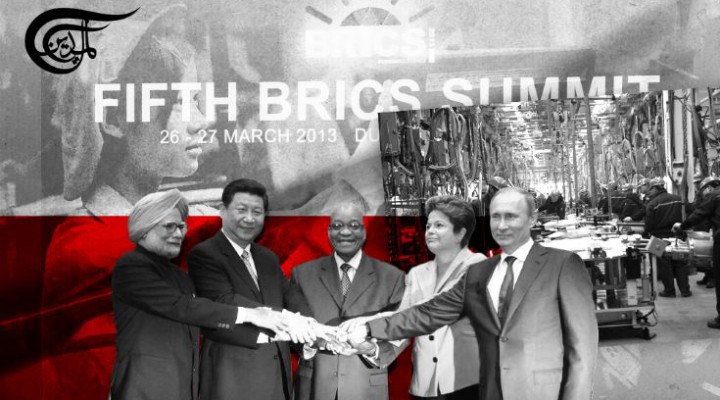The New Commodity Powerhouse

The BRICS 11 now represents 37% of the global GDP (in PPP terms) and 46% of the global population. The G7 GDP is 29.9% (PPP terms), by comparison.
The heterogeneous BRICS grouping ‘did it’ — they came together, despite multiple attempts to ‘wedge-apart’ certain key states. It is a notable diplomatic and geo-strategic achievement, born from the widely-held desire to find a work-around to the US excess weaponisation of its post-WW2 dollar ‘exceptionalism’ — the Bretton Woods and the Petro-dollar ‘mandate’, by which each and every energy and commodity exchange be priced in dollars, and transacted in dollars (thereby rendering prey all states to western sanctions).
This is the bed-rock commonality that has brought about an expanded BRICS. Financial war may have begun in the 1980s with the Plaza Accord which purposefully stagnated Japan’s growth for decades. From February 2022, the US and Europe have been laser-focused on collapsing the Russian economy. And today, the US and EU are girding up to apply the ‘Japan treatment’ to China — through regulation, tariffs and a tightening a ‘national-security’ belt of forbidden trades.
An initial, ad hoc ‘work-about was essential’. And here it is: Trading in own currencies, and clearing own currency trades via a Central Bank system of national digital currencies that would ‘clear’ real-time between Central Banks, without touching the dollar. The system has already been proved in a pilot scheme called ‘m-CBDC Bridge’. The idea is that each BRICS state would retain its own currencies for day-to-day use, with the digital currencies being limited to foreign exchange digital transactions between Central Banks.
The prospect of a common BRICS currency had been much bruited in the western press. But that is for later. (Creating a reserve currency was always a Western red-herring; reserve status is not sought by Russia or China, nor is it an aspiration.)
But perhaps the lack of a ‘new currency’ big media ‘splash’ has led observers to underrate the impact of what has been achieved at this summit. The expansion (with more states to follow next year) gives China the strategic space in which to situate its restructuring of the Chinese economy. It gives Russia and China the scope to fully develop and extend the North-South corridor (INSTC) in both directions. BRICS has embraced two potentially booming economies in Africa, and two in Latin America.
The BRICS 11 now represents 37% of the global GDP (in PPP terms) and 46% of the global population. The G7 GDP is 29.9% (PPP terms), by comparison.
We should expect nothing dramatic to happen immediately. However, the progressive shrinkage in dollar-use across such a large slug of the global economy will transform the global monetary system in a number of ways: As demand for dollars withers (whilst Washington keeps printing more), the value of fiat dollars will slide, which means that to finance new debt, the US will have to pay creditors higher interest (to compensate for the concomitant decline in bond value).
The less noticed ‘cherry’ on the icing, of course, is that with the addition of Iran, UAE, and Saudi Arabia, the BRICS now controls ~54% of the world’s oil production — and incorporates some of the world’s biggest consumers.
In short, the BRICS — with its energy and raw-material resources — has become a commodity powerhouse.
Which brings us to the next two points of commonality amongst an otherwise seemingly disparate grouping: First is that when these states trade in currencies such as the Rouble or the Rial or Remimbi, they will be trading in a currency that has inherent value, based on a commodity, such as oil or gold.
That is, BRICS are lining up commodity value-based currencies versus fiat monetary instruments that will devalue, as inflation eats away its relative value.
The second major point of commonality is the shift out from the grip of the neo-liberal hyper-financialised western model to one that provides for greater national self-sufficiency. Hence the simple questioning of the philosophical underpinnings to the ‘Anglo’ system of politics and economics — which underlie the ‘Rules-Based Order — is as important, in its own way, as simple de-dollarisation.
Non-western states have been saying for some time that the neo-liberal model is at odds with global needs. President Xi said it straight: “The right of the people to independently choose their development paths should be respected … Only the wearer of the shoes knows if they fit or not”.
The flaw here is that with debt-led consumption – as in the western hyper-financialised model – the system capsizes away from wealth creation, and this ultimately makes it impossible to consume as much, or to employ so many of the population.
This attenuation of the real economy, through financialisation and the emphasis on derivative financial ‘products’, sucks the oxygen from the manufacture of real output. So self-reliance erodes, and a shrinking base of real wealth creation supports ever-smaller numbers in adequately-paid employment.
Again, the conceptual shift to building sovereignty through a real-economy approach, as opposed to financialism, will have profound implications for Wall Street — in the longer term. So de-dollarisation, combined with the real-economy paradigm, is potentially world-shaking.
https://english.almayadeen.net/articles/analysis/the-new-commodity-powerhouse
 TheAltWorld
TheAltWorld 
0 thoughts on “The New Commodity Powerhouse”